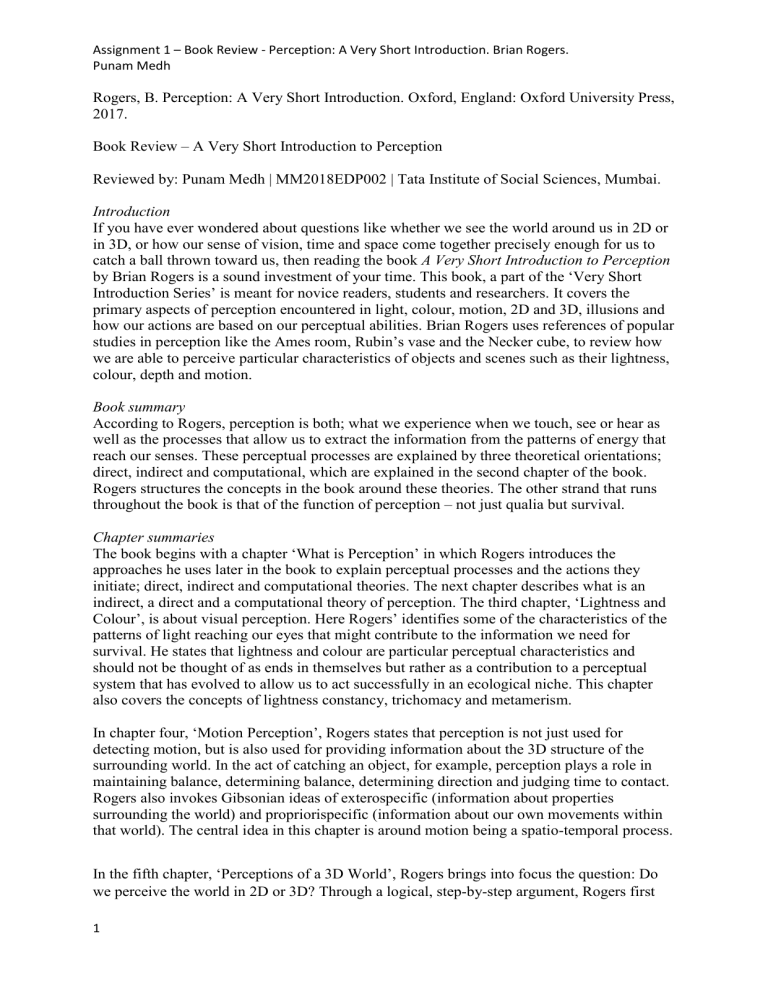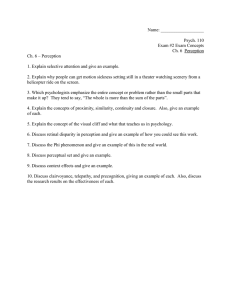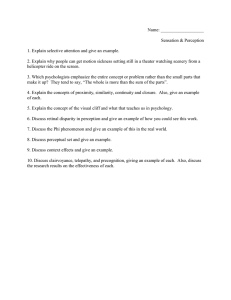
Assignment 1 – Book Review - Perception: A Very Short Introduction. Brian Rogers. Punam Medh Rogers, B. Perception: A Very Short Introduction. Oxford, England: Oxford University Press, 2017. Book Review – A Very Short Introduction to Perception Reviewed by: Punam Medh | MM2018EDP002 | Tata Institute of Social Sciences, Mumbai. Introduction If you have ever wondered about questions like whether we see the world around us in 2D or in 3D, or how our sense of vision, time and space come together precisely enough for us to catch a ball thrown toward us, then reading the book A Very Short Introduction to Perception by Brian Rogers is a sound investment of your time. This book, a part of the ‘Very Short Introduction Series’ is meant for novice readers, students and researchers. It covers the primary aspects of perception encountered in light, colour, motion, 2D and 3D, illusions and how our actions are based on our perceptual abilities. Brian Rogers uses references of popular studies in perception like the Ames room, Rubin’s vase and the Necker cube, to review how we are able to perceive particular characteristics of objects and scenes such as their lightness, colour, depth and motion. Book summary According to Rogers, perception is both; what we experience when we touch, see or hear as well as the processes that allow us to extract the information from the patterns of energy that reach our senses. These perceptual processes are explained by three theoretical orientations; direct, indirect and computational, which are explained in the second chapter of the book. Rogers structures the concepts in the book around these theories. The other strand that runs throughout the book is that of the function of perception – not just qualia but survival. Chapter summaries The book begins with a chapter ‘What is Perception’ in which Rogers introduces the approaches he uses later in the book to explain perceptual processes and the actions they initiate; direct, indirect and computational theories. The next chapter describes what is an indirect, a direct and a computational theory of perception. The third chapter, ‘Lightness and Colour’, is about visual perception. Here Rogers’ identifies some of the characteristics of the patterns of light reaching our eyes that might contribute to the information we need for survival. He states that lightness and colour are particular perceptual characteristics and should not be thought of as ends in themselves but rather as a contribution to a perceptual system that has evolved to allow us to act successfully in an ecological niche. This chapter also covers the concepts of lightness constancy, trichomacy and metamerism. In chapter four, ‘Motion Perception’, Rogers states that perception is not just used for detecting motion, but is also used for providing information about the 3D structure of the surrounding world. In the act of catching an object, for example, perception plays a role in maintaining balance, determining balance, determining direction and judging time to contact. Rogers also invokes Gibsonian ideas of exterospecific (information about properties surrounding the world) and propriorispecific (information about our own movements within that world). The central idea in this chapter is around motion being a spatio-temporal process. In the fifth chapter, ‘Perceptions of a 3D World’, Rogers brings into focus the question: Do we perceive the world in 2D or 3D? Through a logical, step-by-step argument, Rogers first 1 Assignment 1 – Book Review - Perception: A Very Short Introduction. Brian Rogers. Punam Medh leads you to reframing the aforementioned question to a more accurate one: What information is available in the optic array reaching our eyes that can tell us about the 3D structure of the surrounding world? This question is answered by the introduction and explanation of a large number of related concepts, beautifully explained using illustrated examples; occlusion, shape from shading, cues and clues, motion parallax, binocular stereopsis, eye vergence, vertical disparities and primary and secondary depth cues. The central idea in chapter 6 ‘Perception and Action’ is that the perception system would be of little use without an action system and vice versa. Our perceptual systems provide us not just with the qualia (property or quality) of our environment but also allows us to act based on our perception. This relation is evident in low-level tasks such as maintaining our balance, providing information about our movements with the world (self-motion), determining our direction of travel and estimating the time before we reach objects in the surrounding world. Through the evidences produced by David Lee’s experiment ‘Swinging Room’, Gunnar Johansson’s self-motion experiment (and a few more) Rogers asserts the important role optic flow plays in determining our perception of self-motion. This chapter also covers a section of affordances – the main idea being that the role of perception is also to detect the affordances of the world – a Gibsonian thought. In chapter 7 ‘Delusions about Illusions’ Rogers brings forth how the concept of illusions may be classified. Rejecting physical illusions (since they can be explained by laws of physics) Rogers delves deeply into cognitive illusions using some brilliant examples, like Sugihara’s gravity defying illusion. Using a regress style of argument, Rogers leads you to reconsider illusions as reality which in turn is perspective projection that takes place due to lines, surfaces, textures, gradients and so on, thus turning the very idea of illusions on its head. In the penultimate chapter, ‘The Physiology and Anatomy of the Perceptual System’ Rogers provides you with physiological evidence of the theories and concepts discussed in the earlier chapters of the book. He rounds off the book by asserting that even though 2000 years of research has not resulted in a unified theory of perception, the very fact that we are able to ‘deceive’ our perceptual systems is evidence that we understand it completely. Review Brian Rogers’ has managed the feat of packing into a well-structured, but pint-sized volume, some of the most important concepts in perception. He describes the work done by influential researchers in this field beginning with Herman Helmholtz, an indirect theorist, who stated that the physical world is separated from experience, and perception is only indirectly related to external events or objects. Rogers includes the views of Paul Gibson, a direct theorist whose wide ranging studies on textures, surfaces, straight and curved lines and depth, supported his view that the energy patterns we receive carry rich information. Significant importance is given to David Marr, who is credited for discovering a powerful approach to understanding biological information-processing systems by integrating neurophysiological and psychophysical studies with the computational methods of artificial intelligence (AI). If you look for Rogers’ preference of one theory over the other, you might be disappointed or confused even. However, as you continue reading the book it is soon evident that Rogers uses that theory which provides the most logical and elegant explanation of the perceptual phenomena being discussed. For example, while discussing and explaining Sugihara’s illusion or the Muller-Lyer lines, Rogers adopts a Gibsonian line of thought. However he 2 Assignment 1 – Book Review - Perception: A Very Short Introduction. Brian Rogers. Punam Medh shows a preference for computational models of thought in the penultimate chapter of the book ‘The Physiology and Anatomy of the Visual System’. Most of the studies that appear in the book are fleetingly mentioned and are better supported by additional referencing that the reader must do on her own, but even so the book serves as an excellent springboard to further and deeper study of this subject. The book carries a generous number of illustrations (in colour wherever required) to reference the various studies and examples of perception. Having stated that this book provides a rich and essential entry into the subject of perception, it can at the same time be a daunting read for those who have no prior experience in studying the psychology of perception. Certain concepts like top-down and bottom-up approach for example, may not be within the reach of a novice. In the very first chapter, ‘What is Perception’ one expects a descriptive introduction to perception. The reader is instead lead into a philosophical dilemma of reality in perception. This chapter is immediately followed by an overview of perceptual theories which belies the expectation of actually understanding it. Since this book is an introduction to perception for the consumption of a larger audience, it can be better organized by bringing ahead chapters that deal with the more intuitive and natural phenomena about perception – such as illusions, how we detect motion and whether we perceive the world in 2D or 3D. These topics would make it interesting and simple to initiate novices into the study of the subject. The chapters that deal with the more complex aspects about perception, such as direct, indirect and computational theories can be taken up later. This structure would also help reduce the repetition of many of the studies as well as illustrations such as the Ames room, Necker cube, Rubin’s vase and Beethoven’s mask. The chapter on physiology and anatomy of the visual system, is perhaps the most complex, making it hard to comprehend. It would be helpful to have supported the rich contents of this chapter with an explanation of the very same examples already considered in the book. As a final observation, what would help the understanding of perception is a short timeline on the periods in which some of the studies took place. For example, it would surprise you to know the David Marr’s work which has redefined the standard for achieving a suitable comprehension of brain structure and function, which is used today for cutting edge artificial intelligence (AI) applications was proposed way back in the 70s. To conclude, it can be said that although the book requires a small effort and support (from other materials) to read, it is an important resource in the study of perception. References 1. Gordon, I. E. (2004). Theories of visual perception. Hove, England: Psychology Press. 2. Howard, I.P. and Rogers, B.J. (2012). Perceiving in Depth: Vol. 2. Stereoscopic vision. Oxford, UK, Oxford University Press. 3. Keil, F. (Ed.), Wilson, R. (Ed.), The MIT encyclopaedia of the cognitive sciences, 1999, MIT. Retrieved from 3 Assignment 1 – Book Review - Perception: A Very Short Introduction. Brian Rogers. Punam Medh https://www.researchgate.net/publication/230876651_The_MIT_Encyclopedia_of_the_C ognitive_Sciences 4. Wikipedia contributors. (2018, May 23). Optical flow. In Wikipedia, The Free Encyclopedia. Retrieved 11:23, August 28, 2018, from https://en.wikipedia.org/w/index.php?title=Optical_flow&oldid=842522656 4






